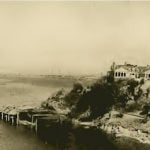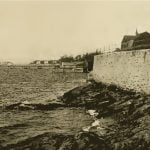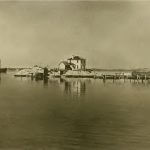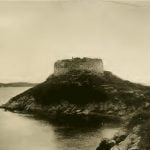
Here is an odd little cluster of islands on the eastern side of the entrance to Narragansett Bay. The most important of these is Aquidneck and on the southern extremity of Aquidneck Isle is situated Newport. At the southern extremity of Newport is Brenton’s Point and on Brenton’s Point is Fort Adams. This is the proper way to build up a climax!
Picture to yourself a sunny Fourth of July in 1799; this is the day on which Fort Adams is to be dedicated with imposing ceremonies. From out of the little many spired city across the sparkling blue waters of Newport Bay winds a little procession around the shore road which leads to the fort. First of all, comes the company of soldiers, which is to garrison the post. It is Captain John Henry’s company of artillery. After this comes the major general of the State militia with his staff in gorgeous gold braid. Following him is the famous Newport Artillery Company with two brass field pieces making a brave show. Then there are the Newport Guards with two brass field pieces. Finally there is a company of citizens.
They are all assembled at the fort. Major Tousard, of the corps of engineers of the army of the infant republic, is speaking: He says: ” Citizens: Happy to improve every occasion to testify my veneration for that highly distinguished citizen who presides over the government of the United States, I have solicited the Secretary of War to name this fortress, Fort Adams. He has gratified my desire. I hope that the brave officers and soldiers who are and shall be honored with its defense will by valor and good conduct render it worthy of its name, which I hereby proclaim Fort Adams.” A salute was fired from the four brass field pieces and the great cannon of the new fort. In the distance Fort Wolcott on Goat Island fired guns and the standard of the young United States was unfurled at the head of the flagstaff. Thus was christened one of the most important of American coast defenses.

Glimpses Of Newport’s Historic Defenses
For twenty-five years thereafter Fort Adams was maintained with a small garrison supplied from Fort Wolcott, under whose jurisdiction it was. In 1824 the present Fort Adams was commenced, a star shaped fortress of grey granite, with outworks, upon an initial appropriation by the Federal government of $50,000. It was finished, under successive appropriations, in 1841. The garrison was withdrawn from 1853 to 1857 and between the years 1859 and 1862, since when it has been continuously occupied. The present area of Fort Adams reservation is about 200 acres, and it contains modern works, which need no description.
If one should go back in point of Time beyond the gay little ceremony, which marked the beginning of Fort Adams, he would find that Brenton’s Point had been a site for martial works before this. Its strategic possibilities for defense were early recognized in the Revolution, as, in the spring of 1776, a light breastwork was thrown up here by the Americans behind which they mounted several guns. In April 1776, the Glasgow, a British war vessel of twenty-nine guns, came into Newport Harbor and anchored near Goat Island. On the following morning such a heavy fire was brought to bear upon the ship from Brenton’s Point that it cut its cable and made out to sea. A few days after this the Scarborough and the Scymetar of His Majesty’s service were, likewise, badly battered by fire from these earthworks.
Late in the summer of 1776 the British obtained possession of Aquidneck Island. They made their headquarters at Newport, and erected a temporary barracks on Brenton’s Point where the American battery had been. For three years they held possession of Rhode Island and then were removed by orders from their commander-in-chief, embarking October 25, 1779.
The next visitors to Newport were the French. The French fleet, under the command of Admiral de Ternay, appeared in Newport Harbor August 10, 1780. General Rochambeau and his army shortly put ashore. General Heath, in command of the American forces in
Rhode Island, was at the wharf to welcome Rochambeau. There were speeches and the American officers wore cockades of black and white as a courtesy to the allies, the cockade of the formal American uniform being black and that of the French, white. It was not long before the French had been made to feel at home and had settled down to a long stay.

Glimpses Of Newport’s Historic Defenses
General Rochambeau’s defenses consisted of a line of earthworks completely enclosing Newport on the north, cutting off access to it by land from any other part of the island. Traces of this line can still be discerned by the inquiring visitor to Newport. Strong temporary fortifications were thrown up at Brenton’s Point on the future site of our Fort Adams, and on all of the islands of the harbor were placed guns. The northern waterfront of the city was held by a strong redoubt, built by Rochambeau and known as Fort Greene. This was at the site of the present Fort Greene Park, at the head of Washington Street.
Rochambeau was the second visitor to these shores with a French army. The first allies had not made a pleasant impression with the Americans, it must be admitted, chiefly because of their leader’s, D’Estaing’s, apparent unwillingness to come to grips with the enemy except where such action might directly benefit his own country. Doubtless he acted on orders from Versailles I But General Rochambeau seemed to be under different instructions, for he immediately placed himself under the authority of the American leaders and ingratiated himself with the people. His stay at Newport is a brilliant chapter in the social history of that city.
One of the pleasantest episodes of the French occupation of Newport was the visit of Washington to his French associate in arms. Rochambeau had chosen as his residence and headquarters the comfortable and beautiful dwelling at the corner of Clarke and Mary Streets known as the Vernon House. In March 1781, Washington, accompanied by his young aide-de-camp, Lafayette, came to Newport and was received here with much formality. The interest with which the French officers regarded their guest is evidenced in some of the journals, which they published at the close of the war on their return to their own country. Amongst minor incidents, Washington led a dance with the beautiful Miss Champlin, and French officers, taking the instruments from the musicians’ hands, played a minuet, “A Successful Campaign.”
A merry time this French occupation of Newport brought about, and traditions of the gayeties and portentous politenesses of the period are still retailed in the little city. A finer body of men than the French army had probably never taken the field. Many had been through the Seven Years War. Officers of the most cultured circles of the Old World embraced a chance of campaigning in the New World with the pleasure of schoolboys in a new experience.
One of the officers of the French force was the Viscount de Noailles, in whose regiment Napoleon was afterward a subaltern. Another was Biron, a figure in the French Revolution, and who in 1793, having unsuccessfully commanded the republican armies in La Vendee, was guillotined. There was the Marquis de Chastellux, an elegant, whose petits soupers became the talk of every one fortunate enough to be invited. Later Chastellux’s “Travels in America” were to become a treasured gallery of pictures of the nation when it was new. There were Talleyrand, Chabannes, Champcenetz, de Melfort, la Touche, de Barras, de Broglie, Vauban, and Berthier, the military confidant of Napoleon, and many others. With such an infusion of genius and culture it is not remarkable that the little city developed an exotic bloom and that the records of this period in Newport are among the gayest in American social history. Nor should one be surprised that the anxious mothers of young daughters of Newport in that time (as we learn now from the betraying evidences of long preserved letters) passed vigilant hours of watchfulness in the sudden maelstrom of French gallantry!
The Chevalier de Ternay, commander at sea of the French forces, died soon after the arrival at Newport and was buried in Trinity churchyard where a slab was erected to his memory.
In 1781 the French marched out of Newport, joined Washington in his campaign at Yorktown, and the result soon was the surrender of Cornwallis and the virtual end of the War of Independence.
In May, 1794, Governor Fenner addressed the following letter to George Champlin, of Newport:
Last evening I received a letter from Mr. Rochefontaine the engineer dated New London . . . informing me that he should depart from New London for Newport this day and desiring me to transmit to him my orders and the names of the gentlemen appointed by me to be the agents for the fortifications and to supervise their execution. I have to ask the favor of you to undertake the business with Col. Sherburne until my arrival at Newport, and to wait on the engineer and deliver him my letter of appointment. Give him the necessary information and assistance. Your compliance will render great service to the State and in a particular manner oblige your ob’t servant,
A. Fenner.

The building of the new fort was assigned to Major Louis Toussard, and soon it was ready for its dedication. At the time of this ceremony the battery was completed and was mounted with 32pounders on seacoast carriages.
Strangely enough it was as a protection from the very allies with whom the United States had triumphed against Great Britain that Fort Adams was called into being. It will be recalled by the reader of history that at this period France under the Directory was in constant embroilment with the United States. Citizen Talleyrand was bent upon turning the new nation to France’s ends. In 1798 a French cruiser actually had the impudence, after the capture of several American vessels, to bring her prizes into an American port to escape the more dreaded British. President Adams, as all know, eventually brought the Directoire Exécutif and Citizen Talleyrand to their senses in no uncertain fashion, but for a time affairs between the two countries were in a very unsatisfactory condition.
To President Adams is due, too, the foundation of the present American navy and the increasing importance of Fort Adams. He saw the necessity in the future for a great naval base well located on the coast. A commissioner sent out by him reported that the harbor of Newport most fully answered the specifications he had in mind, and from this time the works on Brenton’s Point acquired a new value.
The greater part of the construction of the second Fort Adams, which was begun in 1824, was done under the personal supervision of General J. G. Totten of the United States army in coast defense. It is said that during the progress of the work a full set of plans of the fortress mysteriously disappeared and as mysteriously reappeared after a long interval. Gossip also gratuitously asserts that a copy of these plans could be found in the Admiralty office of Great Britain. However that may be, the plans would be of little value to any one today.
Associated with Totten was that General Bernard of the first Napoleon’s staff who was raised from the ranks by the Corsican for his skill as a military engineer. Bernard came to the United States in 1816 and offered his services to the infant republic. While his gifts have been generally conceded, his personality must have been far from winning. Colonel McCree, chief of engineers, resigned rather than serve with him, and harmony between the Frenchman and Colonel Totten was only secured by an agreement through which work was divided and each man was bound to accept the other’s plans.
There are passages beneath the walls of Fort Adams known only to the engineers. These are always closed, for they are of no use in piping times of peace and might become a trap for curious, unwary visitors. A story is told of an exploring party years ago, before the entrances were barred. This party penetrated far beneath the fort. Suddenly their lantern went out and a scream and a splash from the front showed that one of the party was in distress. A beautiful girl had stepped over the edge of a subterranean reservoir. What could be done! There was a rush and another splash. One of the young men had jumped in the dark into the dank pool beside the drowning girl. He was able to keep himself and his fair charge afloat until a rope reached them. The hero of the tale was the late Washington Van Zandt of the Newport family.
During the War of 1812 Fort Adams saw no active service, and this is true, too, of the Civil War.

The vicinity of Newport held many fortified points during the Revolutionary War and some of the remains of these can be seen today. One of the most interesting of these relics is “Dumplings,” at the southern tip of Conanicut Isle. A belligerent little round stone tower, it has as pugnacious an appearance today as it had when a few hardy Americans garrisoned it against the English; and it is a favorite picnic point for parties from Newport or from the summer colonies on the west side of Narragansett Bay. Other ruined defenses (grass grown and decayed) are to be found on Conanicut whose history is so obscure that even legend has little to say about them; but they are all a part of the expression of the doughty spirit, which moved Newport and its vicinity during the Revolution.
Goat Island in Newport Harbor, now the home of the Fort Wolcott torpedo station, and a naval hospital, was, we are told by Edward Field, in his interesting monograph, “Revolutionary Defenses in Rhode Island,” the site of a fortification as early as 1700. This early fortification was known as Fort Anna; later Fort George; then, Fort Liberty; and, at the time of the Revolution, Fort Washington.
